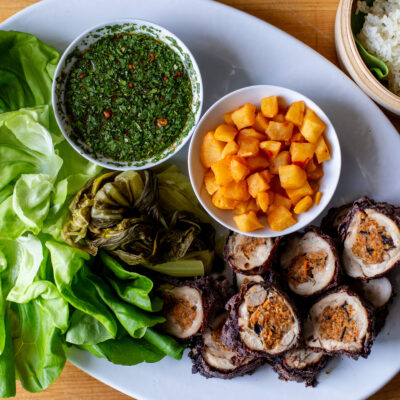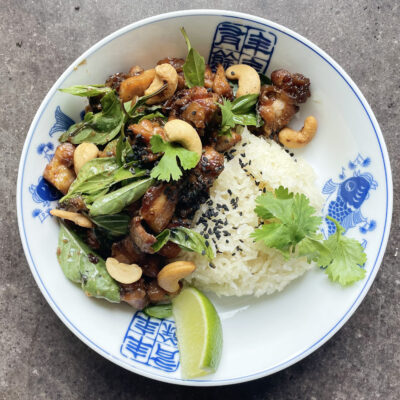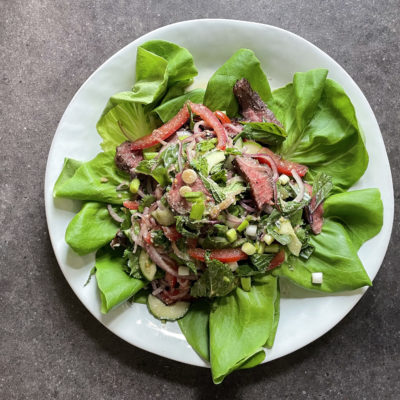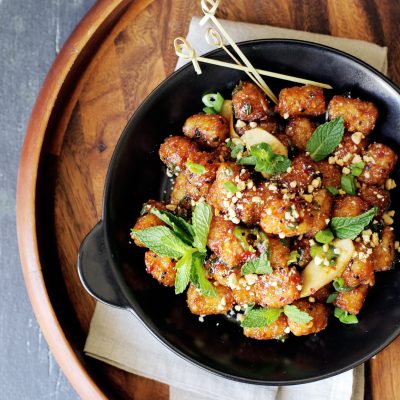Khao Niaw Sankhaya Turian
By Andy Ricker
Durian has a powerful aroma. Westerners, who tend to shun the fruit, would probably choose a stronger term. In Southeast Asia, however, durian is considered the queen of fruit and it fetches a high price. Yet even where durian has fans, it’s not always welcome. Cabs, trains, and hotels throughout Southeast Asia sport signs with a circle around the fruit’s spiky silhouette and a line struck through it.
It took me a while to embrace the fruit, one of many products that remind me of the vast gulf between culinary cultures that prize fermented sea creatures and those dominated by olive oil and lemon. Now I’m a durian fan, for sure. And this custard was my gateway dish, a toe-dip alternative to jumping straight into the yellow lobes of unbelievably rich, almost creamy flesh offered by market vendors kind enough to have already extricated it from the mountains of thorny husks around them. You can eat the custard scooped onto sweet sticky rice, the fruit’s texture and fragrance tempered by coconut milk, egg, and pandan leaf at morning markets. Some of these vendors top this custard with a blob of fresh durian before adding sweet-salty coconut cream.
Whether you’re new to durian or an old hand, this custard is the ideal way to eat the fruit in the US, since the fresh fruit we get here tends not to be as tasty as the frozen kind. Any textural sacrifice from freezing is no big deal, since you’ll be squishing and cooking it anyway. The custard isn’t ultra smooth like a French pot de crème but more like a flan. Leftover custard and sticky rice make a great breakfast.
Sticky Rice with Durian Custard
Ingredients
- 1 1/2 pounds palm sugar
- 3 tablespoons water
- 1 1/2 teaspoons tapioca starch
- 4 ounces defrosted frozen durian flesh
- 1 cup plus 2 tablespoons eggs (about 5 large)
- 1 cup plus 1 tablespoon unsweetened coconut cream (preferably boxed)
- 2 fresh or frozen pandan leaves
- 1/2 teaspoon kosher salt
- Sweet Sticky Rice (see below), warm
Sweet Sticky Rice
- 2 1/2 cups uncooked Thai sticky rice (also called “glutinous” or “sweet” rice)
- 1 cup unsweetened coconut cream (preferably boxed)
- 1/2 cup granulated sugar
- 1 tablespoon kosher salt
- 1 fresh or frozen pandan leaf, tied in a knot
Special Equipment
- A wide aluminum Chinese steamer
- One large or two smaller heatproof bowls or round baking pans (to hold the mixture in an approximately 2-inch layer
- A fine-mesh strainer
- An inexpensive sticky rice steamer set (both the woven basket and pot-bellied pot)
- Cheesecloth or a clean mesh rice-steaming bag
Instructions
Servings: 6 as a hefty snack, and 12 as dessert
Soften the Palm Sugar
Put the palm sugar in a large microwavable bowl, sprinkle on 2 tablespoons of the water, cover the bowl with plastic wrap, and microwave on low just until the sugar has softened (not liquefied), 10 to 30 seconds. Pound the mixture in a mortar (or mash it in the bowl) until you have a smooth paste. Covered, it will keep soft for up to 2 days at room temperature.
Make the Custard
Pour about 3 inches of water into a wide aluminum Chinese steamer, insert the steamer layer, cover, and bring the water to a boil over high heat.
In a small bowl, stir the tapioca starch with the remaining 1 tablespoon of water until it’s smooth and lump free. In a large bowl, combine the durian, eggs, coconut cream, pandan leaves, 1 1/2 cups of the softened palm sugar (reserving extra for another purpose, like papaya salad), salt, and the tapioca mixture.
Use your hands to squeeze and firmly scrunch the ingredients together, especially the pandan, so its flavor infuses into the mixture, until there are no lumps of sugar or durian remaining, about 5 minutes.
Strain the mixture through a fine-mesh strainer into the large heatproof bowl or the two smaller bowls, stirring and smooshing to extract as much liquid as you can and discarding the remaining solids. The mixture should reach a depth of approximately 2 inches. If you’re using two smaller bowls, you might have to cook in batches.
Decrease the heat under the steamer slightly so the water is still boiling but not wildly. Gently stir the mixture, then carefully add the bowl to the steamer basket. Cover the steamer and cook just until the custard has set (a toothpick inserted into the center should come out clean; the custard should jiggle when you gently shake the bowl), 45 minutes to 1 hour. You’ll notice a few nooks and crannies on the surface. That’s fine.
Use oven mitts or towel-wrapped hands to carefully remove the bowl from the steamer. Let the custard cool to room temperature. You can store the custard in the bowl, covered, or in an airtight container in the fridge for up to 5 days. I like to let it come to room temperature before serving, but it’s also good slightly chilled.
Serve the Dish
Put about 1 cup of the sticky rice on each of 6 plates, gently press it to make an even layer, then top each with a scoop (about 1/2 cup, if you’re counting) of the custard.
Sweet Sticky Rice
Serves: 6 as a hefty snack, and 12 as a dessert
Put the sticky rice in a large bowl and add enough tepid tap water to cover by an inch or two. Let it soak for at least 4 hours or up to 10 hours (as long as it’s not very hot in your kitchen; if you’re in a hurry, you can get away with soaking it in hot tap water for as little as 2 hours).
Pour off the soaking water. Put the rice in a fine-mesh strainer set inside a large bowl. Fill the bowl with enough cool tap water to cover the rice by an inch or two. Use your hand to gently stir the rice, then lift the strainer from the bowl. The water in the bowl will be cloudy from the rice starch. Empty the water, set the strainer in the bowl again, and repeat the process until the water is, more or less, clear. You’ll probably have to change the water two or three times. Drain the rice.
Pour enough water into the sticky rice steamer pot to reach a depth of about 2 inches. Bring it to a boil over high heat. Either add the rice to the mesh bag and put the bag in the basket or line the woven steamer basket with two layers of damp cheesecloth and dump the rice onto the cheesecloth. Fold the bag or cheesecloth so it covers the rice, pat the bundle so the rice is in a more or less even layer, and cover with a pot lid or clean, damp kitchen cloth, tucking it around the bundle.
Decrease the heat slightly to maintain a steady but not furious boil and set the basket into the pot. Cook until the grains are fully tender but still chewy (almost springy) and definitely not mushy, about 12 minutes. (Larger batches of sticky rice take about 20 minutes, and the rice bundle should be flipped over once halfway through the steaming process.)
Transfer the rice to a small cooler or large bowl covered with a plate. The sticky rice will stay warm for an hour or so.
Meanwhile, combine the 1 cup of coconut cream, 1/2 cup of sugar, and 1 tablespoon of salt in a medium pot. Add the pandan leaf, set the pot over high heat, and bring the mixture to a simmer (don’t let it boil). Cook, stirring, just until the sugar has fully dissolved, about a minute. Turn off the heat, cover the pot, and let the mixture sit to infuse it with the flavor of pandan, about 5 minutes. Remove and discard the pandan leaf. Let this cream mixture cool just until it’s warm but no longer hot.
Add the cooked sticky rice to the pot and gently stir and fold it until it’s evenly coated in the cream mixture.
The sticky rice mixture keeps covered in the fridge for up to a day. To reheat it , cover with plastic and microwave on low just until the rice is warm (but not hot) through and serve it right away.
Reprinted with permission from Pok Pok by Andy Ricker with J.J. Goode, copyright © 2013. Published by Ten Speed Press, a division of Random House, Inc.
Photography credit: Austin Bush © 2013








